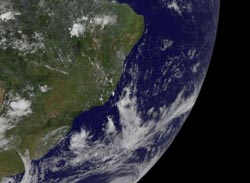90Q: A curious short-lived 'tropical' cyclone in the southern Atlantic

The GOES-12 satellite captured this visible image of System 90Q at 14:45 UTC (9:45 a.m. ET) on March 10, 2010. 90Q is the small circular area of clouds (lower left center). Credit: NASA GOES Project<br>
On Wednesday, March 10 at 1400 UTC (9:00 a.m. ET) “System 90Q” was located near 29.8 degrees South latitude and 48.2 degrees West longitude, about 180 miles east of Puerto Alegre, Brazil.
The Naval Research Laboratory said on March 10 the system had maximum sustained winds near 39 mph (35 knots) but has weakened today below the tropical storm-force winds threshold.
The Geostationary Operational Environmental Satellite, GOES-12 captured a visible image of System 90Q at 14:45 UTC (9:45 a.m. ET) on March 11, and it appeared as a small circular area of clouds off the Brazilian coast. GOES is operated by the National Oceanic and Atmospheric Administration, and NASA's GOES Project, located at NASA's Goddard Space Flight Center, Greenbelt, Md. creates some of the GOES satellite images.
System 90Q continues to move away from the Brazilian coast and is expected to be absorbed in a mid-latitude cold front in the next couple of days.
Media Contact
More Information:
http://www.nasa.govAll latest news from the category: Earth Sciences
Earth Sciences (also referred to as Geosciences), which deals with basic issues surrounding our planet, plays a vital role in the area of energy and raw materials supply.
Earth Sciences comprises subjects such as geology, geography, geological informatics, paleontology, mineralogy, petrography, crystallography, geophysics, geodesy, glaciology, cartography, photogrammetry, meteorology and seismology, early-warning systems, earthquake research and polar research.
Newest articles

High-energy-density aqueous battery based on halogen multi-electron transfer
Traditional non-aqueous lithium-ion batteries have a high energy density, but their safety is compromised due to the flammable organic electrolytes they utilize. Aqueous batteries use water as the solvent for…

First-ever combined heart pump and pig kidney transplant
…gives new hope to patient with terminal illness. Surgeons at NYU Langone Health performed the first-ever combined mechanical heart pump and gene-edited pig kidney transplant surgery in a 54-year-old woman…

Biophysics: Testing how well biomarkers work
LMU researchers have developed a method to determine how reliably target proteins can be labeled using super-resolution fluorescence microscopy. Modern microscopy techniques make it possible to examine the inner workings…





















